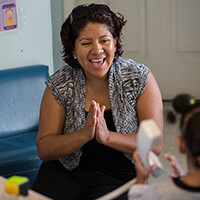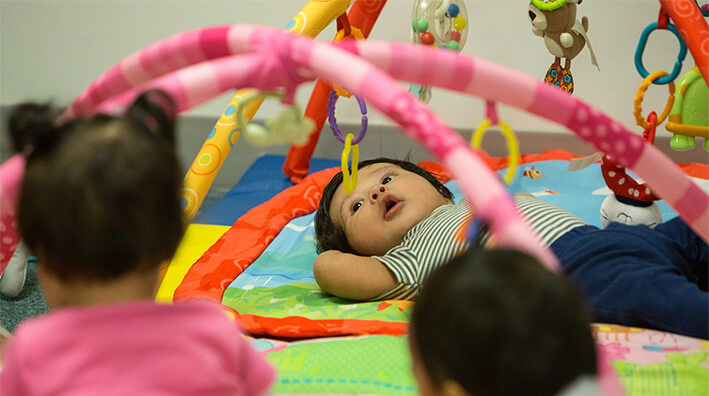Telling a Powerful Story
One of the best ways to spread the word about Head Start is to tell a story about the impact we’ve had for a child or a family. But some ways of telling those stories are more likely to break through than others. For the story to truly strike a chord, it should tell your audience something about an individual and something about Head Start more broadly.
Below are some essential elements of effective Head Start stories. This is by no means a rigid formula, or a strict order to follow. Instead, it’s a starting point to build on as you tell the story in an order and form that feels best to you.

“CEOGC invests in families and nurture them so they can transform their lives. In this forum, we asked staff, "How does your personal practice reflect the mission statement outlined in the Language Playbook?”
–Dr. Thea Wilson, Council for Economic Opportunities in Greater Cleveland, Ohio
The Essential Ingredients
Who the story is about:
Introduce the hero of the story. Is this about an individual person? A family? An organization? Can you paint a picture of who they are?
For example: Last year we partnered with a group of Head Start parents in Ohio
How Head Start was involved:
What was Head Start’s role? How did we partner with this person, family, organization, etc.? Was there something special or different about Head Start’s approach this time? Did we partner with another organization or person to make something happen?
For example: The parents who we partnered with in Ohio were nominated by their communities to be part of our Parent Ambassador program, where Head Start provides a week of personal growth training and public speaking skills.
What the impact or result was:
What was the change from before Head Start was involved, to after? What specifics or details happened that made that change clear? How did we support the person, family, or community?
For example: Later in the year, the Ohio Parent Ambassadors traveled to Capitol Hill, where they shared their stories with members of Congress and made their voices heard.
Why this story relates to a broader narrative about Head Start:
Does this story connect to a piece of our mission, like helping prepare children for school and life or tailoring our approach to each community where we work? What does this story say about who we help? Why is that important?
For example: This story is just one example of how Head Start opens new windows of opportunity for parents. In fact, last year more than 10% of current Head Start parents advanced their education, including finishing a job training program or earning a certification.

Inspiration for other stories we could tell
Consider sharing stories like:
How your program is implementing new tools or technology to help children learn…
How your program plays a role in the local community with job fairs, family goal-setting, and more…
How a parent of a Head Start child got involved in a school, ultimately continuing their education and/or becoming part of the program leadership…
How events like family literacy night, math night, and science night bring families together and provide resources for parents to be actively engaged in their child’s education…
Incorporating Statistics and Data
To really make your story shine, weave in a data point that connects your individual story to a larger whole. Below are some suggestions of statistics that work—and some statistics that are even more effective.
| A good statistic | A better statistic | Here’s why |
|---|---|---|
Head Start children reduce their vocabulary deficit by 38% during the program year. |
Head Start students are more likely to graduate high school, attend college, and receive a post-secondary degree, license, or certification. |
Stick to the positive wherever possible—instead of talking about what’s reduced, talk about what children gain. |
Head Start serves 1 million children in the U.S. each year. |
Head Start serves 1 million children from birth to age 5 in the U.S. at a critical time in their lives. More than 90% of a child’s brain develops from birth to age 4. |
Sometimes two statistics are better than one—especially when they are stats that are hard to argue with, like these. |
A single Head Start program can feed thousands of children a day. |
Every child in a Head Start classroom will be fed each day—for some, the only meals they will eat that day. |
Put the statistic in context to help your audience fully understand what we’re delivering. |
31% of eligible children ages 3 to 5 attend Head Start. |
In 2017, we served over 600,000 children ages 3 to 5 across 57,000 classrooms – and we’re still growing! Our goal is to help serve every eligible child and family who could benefit from Head Start programs and services. |
Put the 31% of children we HAVE served in context of what that number represents – and what opportunities we have in the future. |
As an organization, our language should focus on ALL the children we serve, from birth to age 5, to highlight the holistic impact we have throughout early childhood. That means we should move away from segmenting the children we serve based on their age (i.e., not talking about just children ages 3 to 5), and instead focus on the impact we have from an early age on a child’s brain development and their ability to learn.

Other Ways To Spotlight Our Impact
An area we don’t get enough credit for is how we stimulate and drive economic growth in the communities we serve. Nearly 240,000 people are employed in Head Start centers nationwide.*
We not only employ members of the community to work at our centers, whether they’re teachers, professional and administrative staff, or maintenance crews, but we also contract with local businesses, like construction companies, plumbers, or maintenance crews to keep our buildings operating smoothly. The more people who are gainfully employed or provided with new business opportunities, the more that community, top to bottom, can thrive economically.
There’s another important way we help stimulate economic growth: We help parents attend their work or class schedules without worrying about whether their children have a safe and stimulating environment to be taught in and cared for.
In recent years, Head Start programs have been moving in the direction of extending services to provide all-day, year-round care for children. The benefits are two-fold: we can spend more time providing high-quality learning experiences to children, and we help parents manage their work or class schedules.
* This is inclusive of all staff—not just teachers. Family service workers, bus drivers, finance officers, etc. are in this total number.
